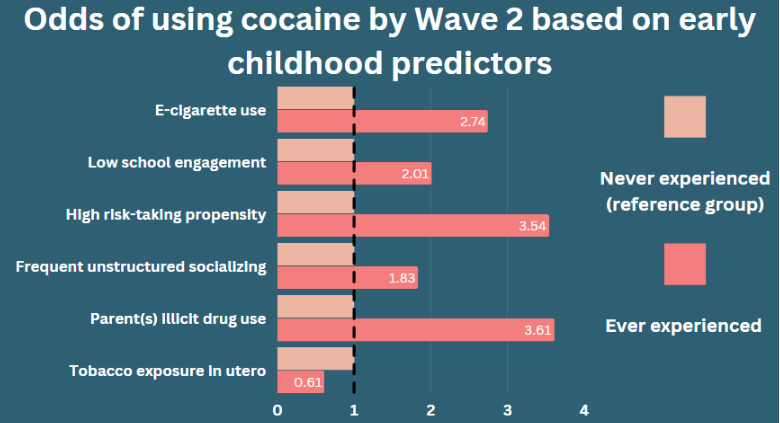Many public health advocates argue that early experiences with softer drugs like alcohol and tobacco can lead individuals towards harder drugs like cocaine and methamphetamines. This theory is called the gateway hypothesis. A prevailing counter-narrative to the gateway hypothesis is the common liability theory, which argues that underlying vulnerabilities such as sensation seeking or childhood poverty explain why many people make this transition. This week, ASHES reviews a study by Constanza Silva and colleagues that examined the relationship between adolescent e-cigarette use and later cocaine use while controlling for underlying vulnerabilities.
What was the research question?
How does adolescent e-cigarette use relate to later cocaine use when accounting for common childhood vulnerability factors?
What did the researchers do?
The researchers used data from the Millennium Cohort Study, a multi-wave longitudinal survey of youth born between 2000 and 2002. Data collection occurred when participants were approximately ages 14 (Wave 1) and 17 (Wave 2). They categorized participants as either vapers or non-vapers based on whether or not they had used e-cigarettes by Wave 1. The survey also inquired about participants’ cocaine use which served as the primary outcome variable for this study. Participants who reported cocaine use prior to Wave 2 were removed from the analysis. To explore shared risk factors, they also gathered data on several common childhood risk factors for substance use including engagement in delinquency and peer substance use. They used coarsened exact matching to match the two groups (vapers and non-vapers) on these important variables to ensure the groups were similar and used logistic regression to determine the likelihood of Wave 2 cocaine use based on adolescent e-cigarette use.
What did they find?
In total, 6.0% of participants reported using e-cigarette by Wave 1 and 3.0% reported using cocaine at Wave 2. Notably, 7.6% of those who used e-cigarettes at Wave 1 reported using cocaine at Wave 2, compared to 3.1% of those who hadn’t used e-cigarettes by Wave 1. Participants who reported using e-cigarettes at Wave 1 had 2.74 times greater odds of reporting cocaine use at Wave 2 compared to non-e-cigarette users even after accounting for the common vulnerability factors (see Figure). Several other childhood common vulnerability factors, like risk-taking, were also highly predictive of Wave 2 cocaine use (see Figure).

Figure. Displays the odds ratios of reporting cocaine use at Wave 2 based on select common childhood risk factors. For example, participants who reported parental illicit drug use had 3.61 times greater odds of reporting cocaine use at Wave 2 compared to participants who did not report parental illicit drug use. Click image to enlarge.
Why do these findings matter?
These findings support the gateway hypothesis because adolescent e-cigarette use independently increased the likelihood of using cocaine later on. Using these findings, public health advocates can more effectively target youth who are at elevated risk for substance use problems. More specifically, nicotine cessation campaigns may be more effective if they teach kids about the links to future cocaine use and how to avoid that risk.
Every study has limitations. What are the limitations in this study?
Due to ethical constraints, a randomized experimental design was not feasible, forcing the research team to rely on observational data which introduces the possibility of confounding variables influencing the results. Additionally, due to the sensitive nature of many collected variables, participants may not have been entirely truthful, limiting the accuracy of collected data. Though this study provides evidence for the gateway hypothesis, these limitations collectively prevent any strong conclusions.
For more information:
Individuals who are concerned about their own smoking or vaping can find resources to help them quit at smokefree.org. Others struggling with their substance use more generally may benefit from using SAMHSA’s National Helpline. For additional tools, please visit the BASIS Addiction Resources page.
—John Slabczynski
What do you think? Please use the comment link below to provide feedback on this article.




